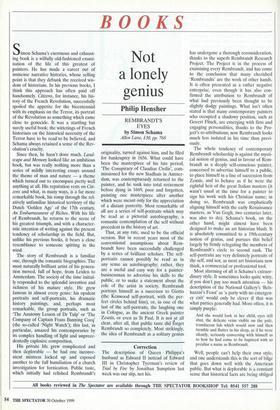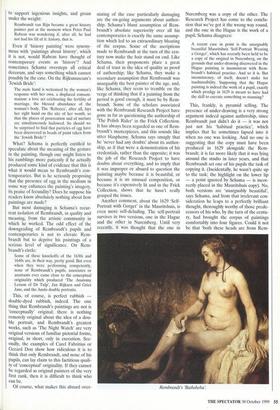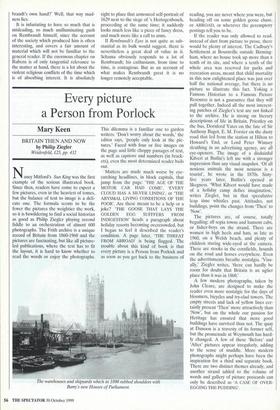BOOKS
Not a lonely genius
Philip Hensher REMBRANDT'S EYES by Simon Schama Allen Lane, £30, pp. 768 Simon Schema's enormous and exhaust- ing book is a wilfully old-fashioned exami- nation of the life of this greatest of painters. He has made a career out of immense narrative histories, whose selling point is that they debunk the received wis- dom of historians. In his previous books, I think this approach has often paid off handsomely. Citizens, for instance, his his- tory of the French Revolution, successfully spoiled the appetite for the bicentennial with its emphasis on the Terror, its portrait of the Revolution as something which came close to genocide. It was a startling but surely useful book; the witterings of French historians on the historical necessity of the Terror have to be read to be believed, and Schema always retained a sense of the Rev- olution's cruelty.
Since then, he hasn't done much. Land- scape and Memory looked like an ambitious book, but was really nothing more than a series of mildly interesting essays around the theme of man and nature — a theme which turned out to encompass pretty well anything at all. His reputation rests on Citi- zens and what, in many ways, is a far more remarkable book, his romp through the rel- atively unfamiliar historical territory of the Dutch 'Golden Age' of the 17th century, An Embarrassment of Riches. With his life of Rembrandt, he returns to the scene of his greatest triumph, and with a character- istic intention of writing against the present tendency of scholarship in the field. But, unlike his previous books, it bears a close resemblance to someone spitting in the wind.
The story of Rembrandt is a familiar one, through the romantic biographies. The most naturally brilliant artist of his genera- tion moved, full of hope, from Leiden to Amsterdam. The society of the time initial- ly responded to the splendid invention and richness of his mature style. He grew famous in almost every genre: his opulent portraits and self-portraits, his dramatic history paintings, and, perhaps most remarkable, the group portraits, such as `The Anatomy Lesson of Dr Tulp' or 'The Company of Captain Frans Banning Cocq' (the so-called 'Night Watch'); this last, in particular, amazed his contemporaries by its complex handling of light and unprece- dentedly explosive composition.
His private life grew complicated and then deplorable — he had one inconve- nient mistress locked up and exposed another to the full humiliation of a church investigation for fornication. Public taste, which initially had relished Rembrandt's
originality, turned against him, and he filed for bankruptcy in 1656. What could have been the masterpiece of his late period, `The Conspiracy of Claudius Civilis', com- missioned for the new Stadhuis in Amster- dam, was contemptuously returned to the painter, and he sank into total retirement before dying in 1669, poor and forgotten, painting one masterpiece after another which were meant only for the appreciation of a distant posterity. Most remarkable of all are a series of self-portraits which may be read as a pictorial autobiography, a romantic contemplation of the self without precedent in the history of art.
That, at any rate, used to be the official version. But in recent years most of the conventional assumptions about Rem- brandt have been successfully challenged by a series of brilliant scholars. The self- portraits cannot possibly be read as in any sense an autobiography; rather, they are a useful and easy way for a painter- businessman to advertise his skills to the public, or to make a statement about the role of fhe artist in society. Rembrandt portrays himself as a successor to Giotto (the Kenwood self-portrait, with the per- fect circles behind him), or, in one of the last of the self-portraits, the laughing one in Cologne, as the ancient Greek painter Zeuxis, or even as St Paul. It is not at all clear, after all, that public taste did forget Rembrandt so completely. Most strikingly, the idea of Rembrandt as a solitary genius has undergone a thorough reconsideration, thanks to the superb Rembrandt Research Project. The Project is in the process of examining every Rembrandt, and has come to the conclusion that many cherished `Rembrandts' are the work of other hands. It is often presented as a rather negative enterprise, even though it has also con- firmed the attribution to Rembrandt of what had previously been thought to be slightly dodgy paintings. What isn't often stated is that many contemporary painters who occupied a shadowy position, such as Govert Flinck, are emerging with firm and engaging personalities, thanks to the Pro- ject's re-attributions; now Rembrandt looks much less isolated in his time than previ- ously.
The whole tendency of contemporary Rembrandt scholarship is against the mysti- cal notion of genius, and in favour of Rem- brandt as a deeply self-conscious painter, concerned to advertise himself to a public, to place himself in a line of succession from Zeuxis, and to behave as if he were the rightful heir of the great Italian masters (it wasn't usual at the time for a painter to sign his work with his Christian name; in doing so, Rembrandt was emphatically aligning himself with the early Renaissance masters, as Van Gogh, two centuries later, was also to do). Schama's book, on the other hand, might almost have been designed to make an art historian blush. It is absolutely committed to a 19th-century notion of genius, and pursues this belief largely by firmly relegating the members of Rembrandt's circle to second rank. The self-portraits are very definitely portraits of the self, and not, as most art historians now think, a commercial or professional tool.
Most alarming of all is Schama's extraor- dinary style. It sometimes looks quite witty, if you don't pay too much attention — his description of the National Gallery's 'Bels- hazzar's Feast' as 'a party with no emergen- cy exit' would only be clever if that was what parties generally had. More often, it is simply purple:
And she would look at her child, eyes still shut, the delicate veins visible on the pale, translucent lids which would now and then tremble and flutter in his sleep, as if he were silently, seriously conversing with himself as to how he had come to be baptised with so peculiar a name as Rembrandt.
Well, people can't help their own style, and one understands this is the sort of bilge that goes down well with the American public. But what is deplorable is a constant sense that historical facts are being obliged to support ingenious insights, and groan under the weight: Rembrandt van Rijn became a great history painter just at the moment when Peter Paul Rubens was wondering if, after all, he had not had his fill of it: history, that is.
Even if 'history painting' were synony- mous with 'paintings about history', which it is not, would Rubens have thought of contemporary events as 'history'? And sometimes Schama oversteps all critical decorum, and says something which cannot possibly be the case. On the Rijksmuseum's `Jewish Bride': The male hand is welcomed by the woman's response with her own, a displaced consum- mation: a love act celebrating the fertility of marriage, the blessed abundance of the woman's body. The `Rebecca', after all, lays her right hand on the site of her womb, so that the places of procreation and of nurture are simultaneously hallowed. So should we be surprised to find that particles of egg have been discovered in beads of paint taken from the `Jewish Bride'?
What? Schama is perfectly entitled to speculate about the meaning of the gesture in the painting, though one might listen to his ramblings more patiently if he actually produced some kind of evidence that this is what it would mean to Rembrandt's con- temporaries. But is he seriously proposing that the presence of egg in the medium in some way enhances the painting's imagery, its praise of fecundity? Does he suppose his readers know absolutely nothing about how paintings are made?
But most damaging is Schama's recur- rent isolation of Rembrandt, in quality and meaning, from the artistic community in which he worked. The odd effect of the downgrading of Rembrandt's pupils and contemporaries is not to elevate Rem- brandt but to deprive his paintings of a serious level of significance. On Rem- brandt's circle: Some of these knockoffs of the 1630s and 1640s are, in their way, pretty good. But even when they were performing competently. none of Rembrandt's pupils, associates or assistants ever came close to the conceptual originality which produced 'The Anatomy Lesson of Dr Tulp', Jan Rijksen and Griet Jans, and the Anslo double portraits.
This, of course, is perfect rubbish double-dyed rubbish, indeed. The one thing that Rembrandt's paintings are not is 'conceptually' original; there is nothing remotely original about the idea of a dou- ble portrait, and Rembrandt's greatest works, such as 'The Night Watch' are very original versions of familiar pictorial forms, original, in short, only in execution. Sec- ondly, the examples of Carel Fabritius or Gerard Dou show how ridiculous it is to think that only Rembrandt, and none of his pupils, can lay claim to this factitious quali- ty of 'conceptual' originality. If they cannot be regarded as original painters of the very first rank, then it is difficult to think who can be.
Of course, what makes this absurd over-
stating of the case particularly damaging are the on-going arguments about author- ship. Schama's blunt assumption of Rem- brandt's absolute superiority over all his contemporaries is exactly the same assump- tion which led to an extraordinary bloating of the corpus. Some of the ascriptions made to Rembrandt at the turn of the cen- tury now make the hair stand on end. Like Schama, their proponents place a great deal of trust in the idea of quality as proof of authorship; like Schama, they make a secondary assumption that Rembrandt was unarguably the best painter of the age, and, like Schama, they seem to tremble on the verge of thinking that if a painting from the period is good enough, it must be by Rem- brandt. Some of the scholars associated with the Rembrandt Research Project have gone as far as questioning the authorship of 'The Polish Rider' in the Frick Collection. It has always been regarded as one of Rem- brandt's masterpieces, and this sounds like utter blasphemy. Schama says smugly that he 'never had any doubts' about its author- ship, as if that were a demonstration of his credentials, rather than the opposite; it was the job of the Research Project to have doubts about everything, and to imply that it was improper or absurd to question the painting maybe because it is beautiful, or because it is an unusual composition, or because it's expensively lit and in the Frick Collection, shows that he hasn't really grasped the issues.
Another comment, about the 1629 'Self- Portrait with Gorget' in the Mauritshuis, is even more self-deluding. The self-portrait survives in two versions, one in the Hague and the other in Nuremberg. Until very recently, it was thought that the one in Nuremberg was a copy of the other. The Research Project has come to the conclu- sion that we've got it the wrong way round, and the one in the Hague is the work of a pupil. Schama disagrees: A recent case in point is the unarguably beautiful Mauritshuis 'Self-Portrait Wearing a Gorget', which has recently been held to be a copy of the original in Nuremberg, on the grounds that under-drawing discovered in the Hague painting is inconsistent with Rem- brandt's habitual practice. And so it is. But inconsistency, of itself, doesn't make for inadmissibility. Supposing that the Hague painting is indeed the work of a pupil, exactly which prodigy in 1629 is meant to have had the skill to execute something so stunning?
This, frankly, is pyramid selling. The presence of under-drawing is a very strong argument indeed against authorship, since Rembrandt just didn't do it — it was not just not his 'habitual practice', which implies that he sometimes lapsed into it when no one was looking. And no one is suggesting that the copy must have been produced in 1629 alongside the Rem- brandt; it is far more likely that it was lying around the studio in later years, and that Rembrandt set one of his pupils the task of copying it. (Incidentally, he wasn't quite up to the task; the highlight on the lower lip — a point ignored by Schama — is incor- rectly placed in the Mauritshuis copy). No, both versions are 'unarguably beautiful', says Schama, and from that irrelevant con- sideration he leaps to a perfectly brilliant thought, thoroughly worthy of those prede- cessors of his who, by the turn of the centu- ry, had brought the corpus of paintings comfortably into four figures. Could it not be that 'both these heads are from Rem-
Rembrandt's 'Bathsheba'.
brandt's own hand?' Well, that way mad- ness lies.
It is infuriating to have so much that is misleading, so much unilluminating gush on Rembrandt himself, since the account of the society which produced him is often interesting, and covers a fair amount of material which will not be familiar to the general reader. If the enormous chapter on Rubens is of only tangential relevance to the matter at hand, there is a lot about the violent religious conflicts of the time which is of absorbing interest. It is absolutely right to place that armoured self-portrait of 1629 next to the siege of 's Hertogenbosch, proceeding at the same time; it suddenly looks much less like a piece of fancy dress, and much more like a call to arms.
If Rembrandt's Eyes is not quite as sub- stantial as its bulk would suggest, there is nevertheless a great deal of value in it. Schama obviously responds to a lot of Rembrandt; his enthusiasm, from time to time, is contagious. But as an account of what makes Rembrandt great it is no longer remotely acceptable.




























































































 Previous page
Previous page